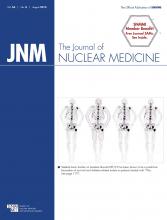A total of 1,665,540 new cancer cases and 585,720 deaths from cancer are projected to have occurred for the United States in 2014, and 1 in 4 deaths in the United States will have been from cancer (1). The reasons for the increasing burden of cancer to society and the meager progress are complex, but one reason is that many cancer standard therapies are ineffective. This is compounded by the increasing difficulty in conducting clinical trials to evaluate new therapies (2).
At the same time, there has been an explosive growth of knowledge of the interactions between many of the genetic drivers of cancer, including oncogenes and tumor suppressors, and insights into the genetic heterogeneity of human tumors that are enabled by exponential improvements in DNA sequencing methods (3). The use of targeted small-molecule anticancer treatments and immunotherapies will likely require diagnostic tests to optimize efficacy (4). For these reasons, molecular imaging characterization of tumors and their habitats is likely to become standard clinical practice in targeted therapies, but for this we need improved tools to help guide drug development, identify critical targets, and determine whether the target or pathway is hit. Such tools will catalyze efforts in precision medicine and help clinicians evaluate choices sooner for individual patients.
See page 1137
Quantitative imaging with PET combined with CT is a valuable tool for assessment of a tumor’s response to therapy and for clinical trials of novel cancer therapies because it can measure functional and molecular changes at multiple tumor sites, with faster and more specific indicators of response than anatomic size changes (5). Success with this approach has been demonstrated using 18F-FDG for evaluation of therapy-induced changes in glucose metabolism in lung cancer (6) and other tumors. Results from the NeoALTTO (Neoadjuvant Lapatinib or Trastuzumab Treatment Optimization) trial in breast cancer showed an early predictive value for human epidermal growth factor receptor–directed targeted therapy (7). Similarly, an early 18F-FDG PET scan predicts response to tyrosine kinase inhibitors in gastrointestinal stromal tumors treated with imatinib (8) and lung cancers treated with gefitinib (9). Although these results and others support the use of 18F-FDG PET as both an integrated and an integral marker in trials of targeted therapy, well-designed prospective studies are needed to firmly establish this role for 18F-FDG PET (10). A key step in the validation of any biomarker is the evaluation of analytic validity—in this case, the quantitative accuracy of the 18F-FDG uptake measures. Specifically, what are the error bars in measurements from the PET images?
The study by Weber et al. (11) in this issue of The Journal of Nuclear Medicine presents needed data for PET to be usable in a clinical trial of new lung cancer studies. By pooling together prospective multicenter test–retest data from the American College of Radiology Imaging Network (ACRIN) 6678 and Merck MK-0646-008 trials (74 patients total) in a rigorous analysis, the authors were able demonstrate the limits of normal variability of tracer uptake in multicenter imaging of advanced non–small cell lung cancer stages III–IV. These limits provide the framework for determining if there has been a response to therapy or if a measured change is due to variations to be expected in practice. There have been previous studies measuring the variability from test–retest studies (as noted by the authors), and although the variability observed in this study is slightly higher than in previous single-center studies, it is similar to the results of a previous carefully controlled multicenter test–retest study in 62 patients with gastrointestinal malignancies (12).
The test–retest results of such studies are needed to determine parameters for the use of quantitative PET/CT imaging for clinical trials and clinical care. Two other important components of such a framework are the definition of response criteria and the comprehensive standards for equipment, protocols, and quality assurance/quality control procedures. The former is provided by the continued development of the PET Response Criteria in Solid Tumors (13), which are supported by the results of this and previous studies. The standards are being provided by several international efforts, including the Quantitative Imaging Biomarker Alliance (14), which in cooperation with other groups (Society of Nuclear Medicine and Molecular Imaging, European Association of Nuclear Medicine, Radiological Society of North America, Food and Drug Administration, National Institute of Standards and Technology, manufacturers, pharma, and others) has developed the Uniform Protocol for Imaging in Clinical Trials (15) and the FDG PET/CT Profile. The Profile is a new type of document that affirms the measurement bias or precision under specific conditions and then specifies what is required to meet the level of measurement accuracy, which includes a subset of the Uniform Protocol for Imaging in Clinical Trials protocol as well as the entire instrumentation chain. Careful evaluation has revealed that the entire imaging chain needs quality assurance/quality control and that even the display stations used for analysis are subject to errors if not checked. Tools for quantitative imaging challenges developed through the National Cancer Institute’s Quantitative Imaging Network (16) and Quantitative Imaging Biomarker Alliance are now being used for the entire acquisition and analysis chain.
Given the challenges with reproducibility and the pooling of data for meta-analysis in biomedical research (17), the sharing of data by Merck and ACRIN is a welcome model of progress in medical imaging research and a foundation for further progress in the development of the precision medicine paradigm. The study by Weber et al. (11) is both an exemplary illustration and a contribution to the necessary data needed to take full advantage of what quantitative molecular imaging can offer for cancer clinical trials, oncologists, and precision medicine for cancer patients (18).
DISCLOSURE
This study was supported by NIH grant U01CA148131. No other potential conflict of interest relevant to this article was reported.
Footnotes
Published online Jun. 18, 2015.
- © 2015 by the Society of Nuclear Medicine and Molecular Imaging, Inc.
REFERENCES
- Received for publication May 12, 2015.
- Accepted for publication May 14, 2015.







